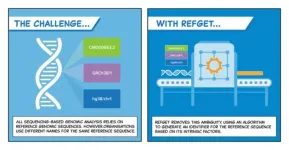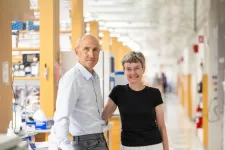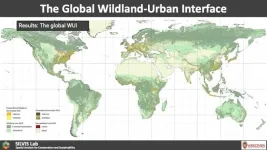(Press-News.org) In a world increasingly concerned about the environmental and geopolitical implications of fossil fuel usage, nuclear energy has resurfaced as a subject of great interest. Its ability to generate electricity at scale without greenhouse gas emissions holds promise as a sustainable clean energy source that could bridge society’s transition away from fossil fuels to a net-zero future. However, nuclear power generation does produce radioactive waste. The safe management of nuclear waste remains a crucial challenge that must be addressed to gain public confidence in this transformative power solution.
Now, a team of University of Houston researchers has come up with an innovative solution for nuclear waste management: molecular crystals based on cyclotetrabenzil hydrazones. These crystals, which are based on a groundbreaking discovery made by the team in 2015, are capable of capturing iodine — one of the most common radioactive fission products — in aqueous and organic solutions, and on the interface between the two.
“This last point is particularly salient because iodine capture on interfaces could prevent the iodine from reaching and damaging the specialized paint coatings used in nuclear reactors and waste containment vessels,” said Ognjen Miljanic, professor of chemistry and corresponding author of the paper detailing the breakthrough in Cell Reports Physical Science.
These crystals exhibit an astonishing iodine uptake capacity, rivaling that of porous metal-organic frameworks (MOFs) and covalent organic frameworks (COFs), which were previously deemed the pinnacle of iodine capture materials.
Alexandra Robles, the first author of the study and a former doctoral student who based her dissertation on this research, was working with the crystals in Miljanic’s lab when she made the discovery. Her interest in finding a solution for nuclear waste led Robles to investigate using crystals to capture iodine.
“She ended up capturing iodine on the interface between the organic and water layers, which is an understudied phenomenon,” said Miljanic, who added that this exceptional feature provides a crucial advantage. “When the material is deposited between the organic and aqueous layer, it essentially stops the transfer of iodine from one layer to another.”
Not only does this process preserve integrity of reactor coatings and enhance containment, but the captured iodine could also then be moved from one area to another. “The idea here is that you capture it at a place where it's difficult to manage, and then you release it at a place where it's easy to manage,” Miljanic said.
The other benefit of this catch-and-release technology is that the crystals can be reused. “If the pollutant just sticks to the regent, the whole thing has to be thrown away,” he said. “And that increases waste and economic loss.”
Of course, all of these great potentials still need to be tested in practical applications, which has Miljanic thinking of the next steps.
Molecules, Crystals and Octopi, Oh My!
Miljanic’s team creates these tiny organic molecules containing only carbon, hydrogen and oxygen atoms using commercially available chemicals.
Each crystal is a ring-shaped structure with eight linear piece emanating from it, which has led the research team to nickname it “The Octopus.”
“They are quite easy to make and can be produced at a large scale from relatively inexpensive materials without any special protective atmosphere,” said Miljanic.
He estimated that he can currently produce these crystals at the cost of about $1 per gram in an academic lab. In an industrial setting, Miljanic believes the cost would drop significantly.
These hungry little crystals are very versatile and can capture more than iodine. Miljanic and his team have used some of them to capture carbon dioxide, which would be another great step toward a cleaner, more sustainable world. In addition, “The Octopus” molecules are closely related to those found in materials used to make lithium-ion batteries, which opens the door to other energy opportunities.
“This is a type of simple molecule that can do all sorts of different things depending on how we integrate it with the rest of any given system,” Miljanic said. “So, we’re pursuing all those applications as well.”
He is excited by the multitude of potential offered by the crystals and looking forward to exploring practical applications. His next goal is to find a partner who will help the scientists explore different commercial aspects.
Until then, the researchers are planning to further explore the kinetics and behaviors of the crystal structures to make them even better.
END
Unlocking the power of molecular crystals: a possible solution to nuclear waste
Potential applications could lead to a net-zero world
2023-07-19
ELSE PRESS RELEASES FROM THIS DATE:
refget v2.0 links the hidden dictionaries of DNA
2023-07-19
A widely-used tool that finds the exact references needed to pinpoint differences in our DNA just got a refresh.
On 17 July, the Standards Steering Committee of the Global Alliance for Genomics and Health (GA4GH) voted to release refget v2.0. With better compatibility for a range of reference genome names, formats, and systems, the new version of refget makes it easier than ever to retrieve verified genomic reference sequences.
A vital infrastructure
You may not even realise that you’re using refget already.
“Almost ...
Do certain amino acids modify the risk of dementia linked to air pollution?
2023-07-19
EMBARGOED FOR RELEASE UNTIL 4 P.M. ET, WEDNESDAY, JULY 19, 2023
MINNEAPOLIS – Higher levels of vitamin B-related amino acids may be linked to the risk of dementia associated with a certain type of air pollutants called particulate matter, according to a study published in the July 19, 2023, online issue of Neurology®, the medical journal of the American Academy of Neurology. The study does not prove that pollution or amino acids cause dementia, but it suggests a possible link among them.
Researchers ...
CHOP and Penn researchers find behavioral economics strategies can help patients quit smoking after a cancer diagnosis
2023-07-19
Philadelphia, July 19, 2023 – Researchers from Children’s Hospital of Philadelphia (CHOP) and the Perelman School of Medicine at the University of Pennsylvania found that cancer patients who continued to smoke after their diagnosis were significantly more likely to receive treatment for tobacco use when “nudges” to provide tobacco treatment were directed at clinicians through the electronic health record. The findings strengthen the case for using behavioral economics, or targeting predictable patterns in human decision-making to overcome ...
Hepatitis cases and heart valve infection deaths tied to early OxyContin marketing
2023-07-19
New Haven, Conn. — Decades after Purdue Pharma began to push physicians to prescribe addictive pain pills, the opioid crisis has been a slow-motion disaster, with overdoses destroying lives and families across the country.
Now, it appears the consequences of those early marketing efforts are even more devastating. In a new study, researchers at the Yale School of Public Health show that infectious disease rates in the United States also climbed as a direct long-term result of the marketing of OxyContin.
By ...
Treatment at the first signs of MS could mean lower risk of disability later
2023-07-19
EMBARGOED FOR RELEASE UNTIL 4 P.M. ET, WEDNESDAY, JULY 19, 2023
MINNEAPOLIS – People who start taking medication soon after the first signs of multiple sclerosis (MS) may have a lower risk of disability later, according to a study published in the July 19, 2023, online issue of Neurology®, the medical journal of the American Academy of Neurology.
MS is a disease in which the body’s immune system attacks myelin, the fatty white substance that insulates and protects the nerves. Symptoms of MS may include fatigue, numbness, ...
Teaching robots to teach other robots
2023-07-19
You’re a poker wizard. A friend knows all about French cuisine. Another friend is a Mozart expert.
The three of you get together and share knowledge about your respective expertise. Each of you leaves learning something from the other two.
People learn a lot by sharing and exchanging information. Can computers do the same with other computers—can robots, in effect, teach other robots how to learn by sharing knowledge?
A team of researchers led by computer science Professor Laurent Itti and one of his Ph.D. students, Yunhao Ge, address this question in ...
Molecular biologists identify framework for understanding RNA editing in a disease-causing parasite
2023-07-19
As molecular biologists at Boston University and as husband and wife, Ruslan Afasizhev and Inna Afasizheva, have worked together for decades. Together, they have published dozens of papers on the mechanics of mitochondrial DNA and RNA in a single-celled, disease-causing parasite called Trypanosoma brucei. Now, years of breakthroughs have led to their latest paper published in Science, which provides a detailed look at a mystifying process called RNA editing and could potentially help treat a deadly disease.
In ...
Picturing where wildlands and people meet at a global scale
2023-07-19
Researchers led by a team at the University of Wisconsin–Madison have created the first tool to map and visualize the areas where human settlements and nature meet on a global scale. The tool, which was part of a study recently published in Nature, could improve responses to environmental conflicts like wildfires, the spread of zoonotic diseases and loss of ecosystem biodiversity.
These areas where people and wildlands meet are called the wildland-urban interface, or WUI for short. More technically, a WUI (pronounced “woo-ee”) describes anywhere that has at least one house per 40 acres and is also 50% covered by wildland ...
Using new method, study highlights physician turnover trend
2023-07-19
Using an innovative method for measuring doctor turnover, Weill Cornell Medicine researchers determined that between 2010 and 2018, the annual rate at which physicians left their practices increased by 43 percent, from 5.3 percent to 7.6 percent a year. The causes of this trend are not known, but warrant further investigation, according to the researchers.
The study, published July 11 in the Annals of Internal Medicine, also found that the first three quarters of 2020 (the start of the COVID-19 pandemic in the United States) were not associated with higher turnover. However, more data are needed to fully understand turnover trends related to COVID-19.
Whether doctors ...
Winery experiences affected by more than what is in your glass
2023-07-19
New research from the University of British Columbia's Okanagan campus has determined that enjoying a tasting at a winery goes well beyond the sip.
Professor Annamma Joy, with UBCO’s Faculty of Management, conducts research in the area of consumer behaviour and branding with a special focus on luxury brands, fashion brand experiences, wineries and wine tourism.
Dr. Joy, along with her collaborators and students, studied several Okanagan wineries over a three-year period to comprehensively document the experiences ...
LAST 30 PRESS RELEASES:
Concurrent frailty + depression likely boost dementia risk in older people
Living in substandard housing linked to kids’ missed schooling and poor grades
Little awareness of medical + psychological complexities of steroid cream withdrawal
Eight in 10 trusts caring for emergency department patients in corridors, finds BMJ investigation
NASA’s Webb telescope finds bizarre atmosphere on a lemon-shaped exoplanet
The gut bacteria that put the brakes on weight gain in mice
Exploring how patients feel about AI transcription
Category ‘6’ tropical cyclone hot spots are growing
Video: Drivers struggle to multitask when using dashboard touch screens, study finds
SLU research shows surge in alcohol-related liver disease driving ‘deaths of despair’
Rising heat reshapes how microbes break down microplastics, new review finds
Roots reveal a hidden carbon pathway in maize plants
Membrane magic: FAMU-FSU researchers repurpose fuel cells membranes for new applications
UN Member States pledge to increase access to diagnosis and inhaled medicines for the 480 million people living with COPD
Combination therapy shows potential to treat pediatric brain cancer ATRT
Study links seabird nesting to shark turf wars in Hawai‘i
Legal sports betting linked to sharp increases in violent crime, study finds
Breakthrough AI from NYUAD speeds up discovery of life-supporting microbes
New Eva Mayr-Stihl Foundation funding initiative boosts research at University of Freiburg on adaptation of forests to global change
The perfect plastic? Plant-based, fully saltwater degradable, zero microplastics
Bias in data may be blocking AI’s potential to combat antibiotic resistance
Article-level metrics would provide more recognition to most researchers than journal-level metrics
Satiety’s little helper: Protein that supports appetite regulating protein identified
UF dives deep into predicting storm damage with computer models
A stormy ocean voyage yields insights on the global carbon cycle
Scientists identify first non-coding gene that controls cell size
Demonstration of altermagnetism in RuO₂ thin films -- A new magnetic material for the AI era
Penn researchers awarded $25M to conduct trial using smartphones to fight heart disease
PCORI awards funding for new patient-centered healthcare research
Exploring the origins of the universe: 145 low-noise amplifiers complete ALMA telescopes
[Press-News.org] Unlocking the power of molecular crystals: a possible solution to nuclear wastePotential applications could lead to a net-zero world



